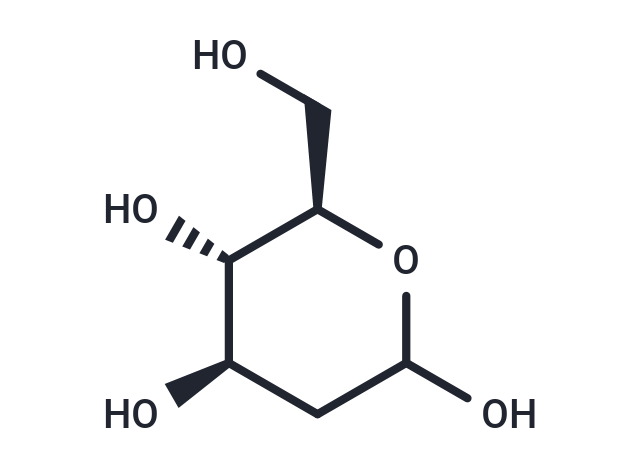Shopping Cart
- Remove All
 Your shopping cart is currently empty
Your shopping cart is currently empty

2-Deoxy-D-glucose (2-DG) is an analog of glucose, an inhibitor of glycolysis. 2-Deoxy-D-glucose has antiviral activity, as well as inhibitory cell proliferation and apoptosis-inducing activity.

| Pack Size | Price | Availability | Quantity |
|---|---|---|---|
| 500 mg | $33 | In Stock | |
| 1 g | $45 | In Stock | |
| 5 g | $113 | In Stock | |
| 10 g | $163 | In Stock | |
| 1 mL x 10 mM (in DMSO) | $48 | In Stock |
| Description | 2-Deoxy-D-glucose (2-DG) is an analog of glucose, an inhibitor of glycolysis. 2-Deoxy-D-glucose has antiviral activity, as well as inhibitory cell proliferation and apoptosis-inducing activity. |
| In vitro | METHODS: Pancreatic cancer cells MIA PaCa2, BxPC-3, ASPC-1 and ovarian cancer cells OVCAR-3, HEY, SK-OV-3 were treated with 2-Deoxy-D-glucose (0.01-100 mM) for 48 h. Cell proliferation was detected using MTT. RESULTS: 2-Deoxy-D-glucose showed significant antiproliferative activity against tumor cells with IC50 values ranging from 1.45-13.34 mM. [1] METHODS: Triple-negative breast cancer cells Hs578T were treated with 2-Deoxy-D-glucose (15 mM) for 24 days, and cell motility was detected by Migration assay and Invasion assay. RESULTS: 2-Deoxy-D-glucose inhibited the migration and invasion of Hs578T cells. [2] |
| In vivo | METHODS: To study the effects on leukocyte subpopulation distribution and function, 2-Deoxy-D-glucose (500-1500 mg/kg) was injected intraperitoneally into BDF1 mice once or thrice. RESULTS: Blood glucose concentrations increased in a dose-dependent manner in mice injected with up to 1500 mg/kg of 2-Deoxy-D-glucose. Corticosterone levels, leukocyte counts in the spleen, and CD3+ cells in the thymus increased after one or three injections of 2-Deoxy-D-glucose up to 1500 mg/kg. 2-Deoxy-D-glucose administration induced dose-dependent changes in thymic and splenic cell distribution and function. [3] METHODS: To test the antitumor activity in vivo, 2-Deoxy-D-glucose (1000 mg/kg) was administered intraperitoneally to C57BL/6 mice bearing melanoma B16 once daily for eight days. RESULTS: 2-Deoxy-D-glucose significantly inhibited tumor growth, and TAMs showed a significant decrease in Arg, Fizz, CD206 and Vegf expression after 2-Deoxy-D-glucose treatment. [4] |
| Cell Research | 2×103 H460 or H157 cells are seeded in 96-well cell culture plates. Cells are treated with 5 mM 2-DG only, 5 or 10 μM IGF1R inhibitor II only, or a combination of 2-DG and IGF1R inhibitor II. Cell growth inhibition is determined after 48 h by the CellTiter 96® AQueous nonradioactive cell proliferation assay. (Only for Reference) |
| Alias | NSC 15193, D-Arabino-2-deoxyhexose, Ba 2758, 2-DG, 2-deoxyglucose, 2-Deoxy-D-arabino-hexose |
| Molecular Weight | 164.16 |
| Formula | C6H12O5 |
| Cas No. | 154-17-6 |
| Smiles | OC[C@H]1OC(O)C[C@@H](O)[C@@H]1O |
| Relative Density. | 1.533 g/cm3 |
| Storage | store at low temperature,store under nitrogen,keep away from direct sunlight | Powder: -20°C for 3 years | In solvent: -80°C for 1 year | Shipping with blue ice. | |||||||||||||||||||||||||||||||||||
| Solubility Information | H2O: 100 mg/mL (609.16 mM), Sonication is recommended. DMSO: 60 mg/mL (365.5 mM), Sonication is recommended. | |||||||||||||||||||||||||||||||||||
Solution Preparation Table | ||||||||||||||||||||||||||||||||||||
DMSO/H2O
| ||||||||||||||||||||||||||||||||||||

Copyright © 2015-2025 TargetMol Chemicals Inc. All Rights Reserved.